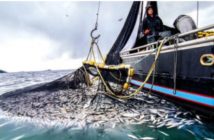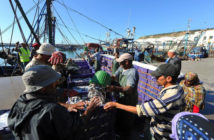 The Moroccan fisheries sector performed well in 2012, a positive step in the government’s effort to boost the sector’s contribution to GDP. The volume of fish and other seafood commercialised last year rose 21% year-on-year (y-o-y) to reach 1.19m tonnes. The value of the annual catch also grew by 2% y-o-y to Dh5.56bn (€494.46m), according to year-end statistics from the National Fisheries Office (Office National des Pêches, ONP).
The Moroccan fisheries sector performed well in 2012, a positive step in the government’s effort to boost the sector’s contribution to GDP. The volume of fish and other seafood commercialised last year rose 21% year-on-year (y-o-y) to reach 1.19m tonnes. The value of the annual catch also grew by 2% y-o-y to Dh5.56bn (€494.46m), according to year-end statistics from the National Fisheries Office (Office National des Pêches, ONP).
The fisheries sector currently accounts for 2-3% of GDP but it has the potential to further develop Morocco’s agricultural production and increase export revenue. To harness these resources, the government introduced a sector development strategy in 2009, Plan Halieutis, which aims to boost the annual catch to 1.6m tonnes and triple the sector’s contribution to GDP to Dh21bn (€1.87bn) by 2020. While these plans to deepen the sector have been slow to get off the ground, the 2012 performance bodes well for future development.
Three quarters of last year’s national catch, corresponding to 63% of its total value, came from commercial fishing on the Atlantic coast; this segment saw a 25% increase in its catch volume over the previous year. Morocco is also one of the world’s largest producers of sardines, with the segment seeing a 29% increase in volume and a 25% bump in value.
While agricultural exports declined across the board due to poor weather conditions during the 2011-12 season, exports of both fresh and processed seafood products increased markedly in 2012. Exports of canned and preserved fish rose 27.9% y-o-y for an additional income of Dh1.19bn (€105.83m), and exports of fresh fish grew by 17% for an additional Dh287.1m (€25.53m). This influx helped to stabilise overall agricultural export levels for the year, which dipped slightly from Dh28.64bn (€2.55bn) in 2011 to Dh28.46bn (€2.53bn) in 2012.
A steady performance in fish processing industries also holds promise for sector development. The majority of the harvest goes toward fresh consumption, and the remainder is divided among a handful of key processing activities, including freezing, canning and derivative products. In 2012 there were slight increases in the amount of the catch that went to fresh consumption and canning: just over 38% of the catch was commercialised as fresh fish, up from 37% in 2011; 28.5% of the catch was commercialised as frozen fish; 18.5% went to the production of fish meal and fish oil; and 13.3% was canned or otherwise preserved.
While the processing industries represent an important economic activity, the sector is only moderately diversified. The National Federation for Seafood Processing Industries put forward a report in 2009 that identifies 40 additional products that could potentially develop the industry. However, the development of the fisheries sector is held back by a number of structural weaknesses in terms of processing and harvesting operations, which Plan Halieutis aims to address.
Plan Halieutis also aims to double exports to $3.1bn (€2.3bn) and increase employment from roughly 62,000 to 115,000 by 2020, outlining 16 major projects in a number of segments. To support growth in processing industries, the plan will create national centres in key fishing areas such as Dahkla, Laâyoune and Tan-Tan, which will help to reduce costs, maximise the value of infrastructure, and ensure that producers have access to high-quality inputs.
Several of the projects also aim to strengthen infrastructure, equipment and fisheries practices to increase productivity. One modernisation goal is to equip all Moroccan vessels with refrigeration systems. Today, the proportion of the national seafood harvest hauled in by boats equipped with holds for refrigerating or freezing fish immediately following the harvest is 23% Boosting this percentage would help to improve the quality and value of the product.
Aquaculture has also been identified as a high-priority segment for development under Plan Halieutis. Fish farming remains marginal, with roughly 1000 tonnes produced in 2011, and is restrained by issues such as land availability, expensive startup costs and heavy dependence on export markets. However, the government has high hopes for the sector. Plan Halieutis set the goal of raising annual production to 200,000 tonnes by 2020 for a turnover of Dh5bn (€444.66m).
In the short term, the National Agency for the Development of Aquaculture launched a call to tender for the construction of nine aquaculture farms ranging between 20 ha and 40 ha on the Mediterranean coast, expected to generate a total investment of Dh295m (€26.24m).
Before the fisheries sector can truly take off, authorities will need to reduce the size of the informal sector, encourage the decentralisation of oversight to strengthen governance and representation, and improve sector infrastructure. And yet, steady growth in the annual harvest, exports and processing industries bode well for future expansion.






